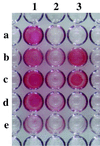The intercellular adhesion (ica) locus is present in Staphylococcus aureus and is required for biofilm formation
- PMID: 10496925
- PMCID: PMC96900
- DOI: 10.1128/IAI.67.10.5427-5433.1999
The intercellular adhesion (ica) locus is present in Staphylococcus aureus and is required for biofilm formation
Abstract
Nosocomial infections that result in the formation of biofilms on the surfaces of biomedical implants are a leading cause of sepsis and are often associated with colonization of the implants by Staphylococcus epidermidis. Biofilm formation is thought to require two sequential steps: adhesion of cells to a solid substrate followed by cell-cell adhesion, creating multiple layers of cells. Intercellular adhesion requires the polysaccharide intercellular adhesin (PIA), which is composed of linear beta-1,6-linked glucosaminylglycans and can be synthesized in vitro from UDP-N-acetylglucosamine by products of the intercellular adhesion (ica) locus. We have investigated a variety of Staphylococcus aureus strains and find that all strains tested contain the ica locus and that several can form biofilms in vitro. Sequence comparison with the S. epidermidis ica genes revealed 59 to 78% amino acid identity. Deletion of the ica locus results in a loss of the ability to form biofilms, produce PIA, or mediate N-acetylglucosaminyltransferase activity in vitro. Cross-species hybridization experiments revealed the presence of icaA in several other Staphylococcus species, suggesting that cell-cell adhesion and the potential to form biofilms is conserved within this genus.
Figures





References
-
- Augustin J, Rosenstein R, Wieland B, Schneider U, Schnell N, Engelke G, Entian K-D, Götz F. Genetic analysis of epidermin biosynthetic genes and epidermin-negative mutants of Staphylococcus epidermidis. Eur J Biochem. 1992;204:1149–1154. - PubMed
-
- Baker A S, Schein O D. Ocular infections. In: Bisno A L, Waldvogel F A, editors. Infections associated with indwelling medical devices. 2nd ed. Washington, D.C: ASM Press; 1994. pp. 111–134.
-
- Bradford M M. A rapid and sensitive method for the quantitation of microgram quantities of protein utilizing the principle of protein-dye binding. Anal Biochem. 1976;72:248–254. - PubMed
-
- Brückner R. Gene replacement in Staphylococcus carnosus and Staphylococcus xylosus. FEMS Microbiol Lett. 1997;151:1–8. - PubMed
-
- Christensen G D, Baldassarri L, Simpson W A. Colonization of medical devices by coagulase-negative staphylococci. In: Bisno A L, Waldvogel F A, editors. Infections associated with indwelling medical devices. 2nd ed. Washington, D.C: American Society for Microbiology; 1994. pp. 45–78.
Publication types
MeSH terms
Substances
Associated data
- Actions
Grants and funding
LinkOut - more resources
Full Text Sources
Other Literature Sources
Molecular Biology Databases
Miscellaneous

